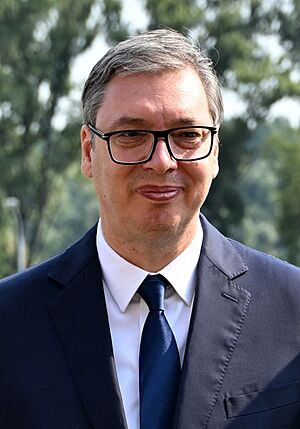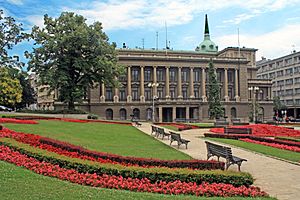President of Serbia facts for kids
Quick facts for kids President of the Republic of Serbia |
|
|---|---|
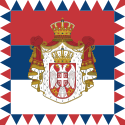
Presidential standard
|
|
| Office of the President of Serbia | |
| Style | His Excellency |
| Seat | Novi Dvor, Andrićev Venac 1, Belgrade |
| Appointer | Direct popular vote |
| Term length | Five years
renewable once
|
| Constituting instrument | Constitution of Serbia (2006) |
| Inaugural holder | Slobodan Milošević |
| Formation | 11 January 1991 |
| Deputy | President of the National Assembly |
| Salary | 240,479 RSD (€2,051) monthly |
| Serbia |
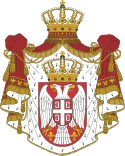 This article is part of the series: |
|
|
|
|
|
The President of Serbia is the main leader of the country, Serbia. This important job is officially called the President of the Republic. The current President is Aleksandar Vučić. He was first elected in 2017 and has been in office since May 31, 2017.
The Constitution of Serbia explains what the President does. The President represents Serbia to other countries and at home. They suggest who should be the Prime Minister of Serbia to the National Assembly of Serbia. The President also helps guide Serbia's foreign policy by choosing and removing ambassadors. They lead the Serbian Armed Forces. The President has some power in how the government runs. They can also dissolve the National Assembly and call for new parliamentary elections.
The President gets help from a team called the General Secretariat. This team includes a general secretary and special advisers. The President's main office is in the Novi Dvor building in Belgrade. People in Serbia vote directly for their President every five years. A President can serve for two five-year terms. A President's term ends when their time is up, or if they resign or are removed from office by the National Assembly.
The job of President of Serbia started in 1991. Slobodan Milošević was the first person to hold this position. Before 2006, Serbia had a "semi-presidential" system. This meant the President had more power. Now, Serbia has a "parliamentary" system, where the Prime Minister and Parliament have more daily power. If the President resigns or cannot do their job, the President of the National Assembly can take over for up to three months. Former Presidents of Serbia can still use the title "Former President of the Republic." They can also attend state events and receive part of their salary for a short time after leaving office.
Contents
What the President Does
The powers and duties of the President of Serbia are explained in the Constitution of Serbia. They are also detailed in laws about the President and their election. The President represents Serbia both inside the country and when dealing with other nations. They officially announce new laws. The President suggests a candidate for Prime Minister of Serbia to the National Assembly of Serbia. They also suggest other important officials to the National Assembly.
The President chooses and removes Serbia's ambassadors to other countries. They also welcome ambassadors from other countries who come to Serbia. The President can grant pardons and give out awards. The President has the same legal protection as members of the National Assembly. This means they cannot be easily sued for things they do in their official role. The President cannot hold other public jobs at the same time.
Foreign Policy and Defence
Serbia's foreign policy is managed by the National Assembly, the President, and the Prime Minister. The President's job includes welcoming foreign ambassadors and choosing Serbia's own ambassadors. When it comes to defence, the President leads the Serbian Armed Forces. They can also choose, promote, and remove army officers. Even though the President leads the army, the Constitution does not call them the "commander-in-chief."
The President is part of the National Security Council. This group also includes the Prime Minister, deputy prime ministers, and ministers of defence, internal affairs, and finance. If the National Assembly cannot meet, the President, Prime Minister, and President of the National Assembly can decide together to declare a state of emergency or war.
Making Laws
The President of Serbia is part of the government's executive branch, along with the government itself. However, the President has limited power in how the government runs things day-to-day. The President's role is not just ceremonial. They have specific duties in Serbia's parliamentary system. The President cannot suggest new laws to the government.
The President must issue a decree to make a law official. They can also veto laws. This means they can send a law back to the National Assembly for another discussion. If the National Assembly votes for the law again, even after the President's veto, then the President must make it official.
Dissolving Parliament
The President has the power to dissolve the National Assembly and call for new parliamentary elections. The President must dissolve the National Assembly 90 days before its term ends. Then, new elections must be held within the next 60 days.
The President also has to dissolve the National Assembly if a new government is not chosen within 90 days of a new parliamentary session. Or, if a new government is not chosen within 30 days after a vote of no confidence. A parliamentary term usually lasts four years. But it can end earlier if a snap election is called. A snap election happens if the government suggests dissolving the National Assembly, or if the National Assembly fails to choose a new government after the Prime Minister resigns. The President can, however, say no to the government's idea to dissolve the National Assembly. An election campaign must last between 45 and 60 days.
President's Office Team
The General Secretariat is the office that helps the President of Serbia. It includes the President's personal cabinet and the office of the general secretary. As of July 2025, Suzana Paunović is the general secretary. The office also has advisers who help the President. These advisers include Tatjana Jović, Milorad Veljović, Suzana Vasiljević, Verica Lazić, Nenad Mihailović, Dejan Savić, Branka Đukić, and Miloš Vučević. The President's monthly salary is about 240,479 Serbian dinars (around 2051 Euros).
Novi Dvor Building
The President's main office is in the Novi Dvor building. It is located at Andrićev Venac 1 in Belgrade. This building was constructed between 1911 and 1922. It was originally built for the royal family, the House of Karađorđević. The architect was Stojan Titelbah. The Karađorđević family used the building from 1922 to 1933. After that, it became a museum from 1934 to 1948.
After 1948, the building was used by the National Assembly of Serbia. Since the job of President of Serbia was created, the Novi Dvor has been the President's official seat. Some people say there is an underground tunnel connecting Novi Dvor to the old National Assembly building. That old building is now where the Republic Electoral Commission works.
How the President is Elected
The President of Serbia is chosen in a direct election where people vote secretly. This election happens every five years. The President of the National Assembly announces the election 90 days before the current President's term ends. The election must then be held within the next 60 days.
To win, a candidate needs to get more than half (50%) of all the votes. If no candidate gets more than half in the first round, then a second round of voting is held. This second round includes only the top two candidates from the first round. In the second round, the candidate with the most votes wins. Any adult who is a Serbian citizen can become a candidate for President. They can be suggested by a group of citizens, a political party, or a group of political parties working together.
According to the Constitution of Serbia, the President says a special oath when they start their job:
I solemnly swear that I will devote all my efforts to the preservation of the sovereignty and the integrity of the territory of the Republic of Serbia, including Kosovo and Metohija as its integral part, as well as the realisation of human and minority rights and freedoms, respect and defense of the Constitution and laws, preservation of peace and well-being of all citizens of the Republic of Serbia, and that I will conscientiously and responsibly fulfill all my duties.
A President's term lasts for five years. It starts on the day they take this oath in front of the National Assembly. A President can only serve two terms. A President's term can be made longer if there is a war or a state of emergency. The term ends when it officially expires, or if the President resigns or is removed from office by the National Assembly. If the President resigns, they must tell the National Assembly about their decision.
History of the Presidency
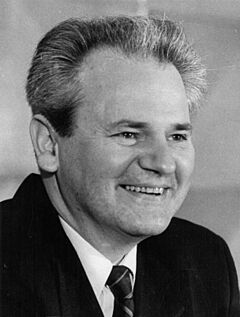
After World War II, the highest official in Serbia was the president of the Presidency of the National Assembly. The job of President of Serbia did not exist yet. The first person in that role was Siniša Stanković. In 1953, the top job became the President of the National Assembly of Serbia. Later, in 1974, it changed to the President of the Presidency of Serbia.
The position of President of Serbia was created in 1990. Slobodan Milošević was the first person elected to this new office. He took his oath on January 11, 1991. Experts say that under the 1990 Constitution, Serbia had a "semi-presidential" political system. This meant the President had a lot of power. Milošević stayed in office until 1997.
After Milošević, Milan Milutinović became President in December 1997. When Milutinović's term ended, several elections were held between 2002 and 2003. However, not enough people voted in these elections for a President to be officially chosen. In the 2004 election, the rules about voter turnout were changed. This allowed Boris Tadić to be elected President.
In 2006, a new Constitution was put in place. This made Serbia a parliamentary republic. This means the Prime Minister and Parliament have more power in running the country day-to-day. In January 2008, Tadić was re-elected President. In 2012, Tadić resigned early so that the presidential election could happen at the same time as the parliamentary elections. He was the first President of Serbia to resign from office. Tadić lost that election to Tomislav Nikolić. Nikolić became President and stayed in office until 2017. He was then followed by Aleksandar Vučić. Vučić took office on May 31, 2017. He won his second term in 2022 and was sworn in again on May 31, 2022.
When the President's Job is Empty or They Can't Work
If the President resigns, is removed from office, or cannot do their job, the President of the National Assembly of Serbia takes over. They can act as President for up to three months. The President can be removed from office if at least two-thirds of the members of the National Assembly vote for it.
Several people have served as acting President in the past. Dragan Tomić was acting President between Milošević's and Milutinović's terms. Nataša Mićić, Dragan Maršićanin, Vojislav Mihailović, and Predrag Marković were acting Presidents between Milutinović's and Tadić's terms. Mihailović only served for one day in March 2004. Since the new Constitution in 2006, Slavica Đukić Dejanović has been the only acting President. She served between Tadić's and Nikolić's terms.
After Being President
After their term ends, former Presidents of Serbia can still use the title "Former President of the Republic." They can also attend state events, following special rules. For up to six months after their term ends, former Presidents can receive 80% of the presidential salary. This continues until they find a new job or retire. Also, former Presidents have the right to an office, an adviser, a secretary, and a car with a driver. They get these benefits for the same amount of time they served as President.
See also
 In Spanish: Presidente de Serbia para niños
In Spanish: Presidente de Serbia para niños
- Politics of Serbia
- Prime Minister of Serbia


